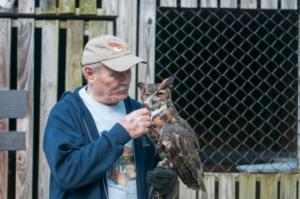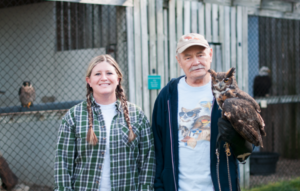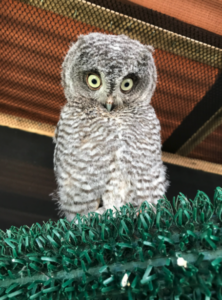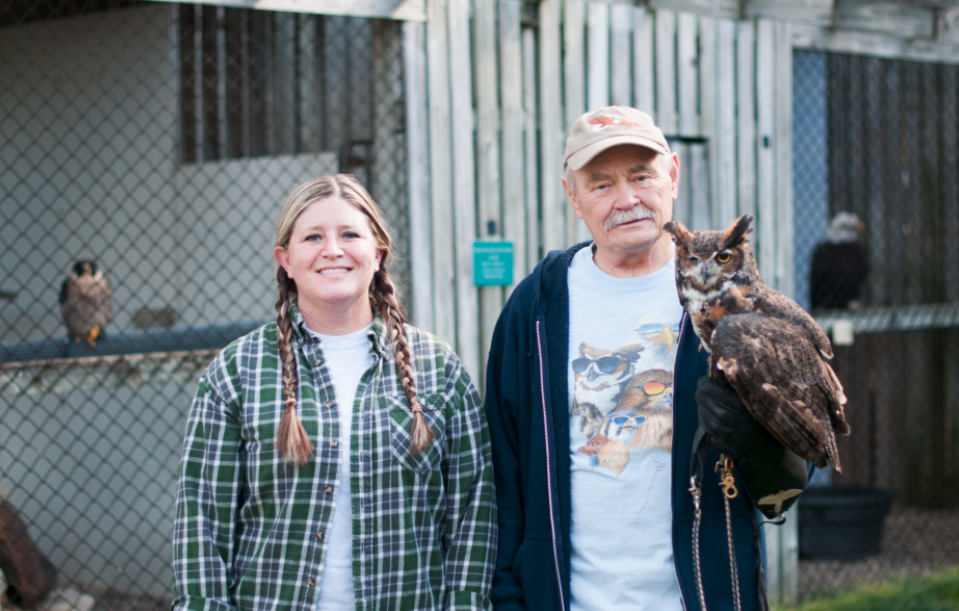For the Birds
Flying High With Raptor Rehabilitation of Kentucky, Inc.
Writer / Julie Engelhardt
Photography Provided
 Our beautiful state is home to an abundance of spectacular wildlife on land, in the water and in the air. In good times, these creatures are well-equipped to care for themselves without a great deal of human intervention, but there are instances when they need our help.
Our beautiful state is home to an abundance of spectacular wildlife on land, in the water and in the air. In good times, these creatures are well-equipped to care for themselves without a great deal of human intervention, but there are instances when they need our help.
This is when centers such as Raptor Rehabilitation of Kentucky, Inc. are extremely essential. It is a nonprofit, volunteer-run organization that tends to eagles, hawks, turkey vultures, owls and other birds of prey if they become sick, orphaned, displaced or injured.
The center was started in the 1980s by John and Eileen Wicker. Eileen had been volunteering as a docent at the Louisville Zoo when she learned that their raptor program was in need of further assistance. She jumped on board and stayed for three years, formulating the idea of opening a place of her own to rehabilitate these special birds.
Our rehab center was something we could do on the weekends, John Wicker says. We worked out of our basement, our garage and our backyard.
The permanent center, located in a quiet neighborhood in West Buechel, began to take shape in 1992.
The volunteers today have it good, Wicker says. When we first started, we had gravel floors, no heat, no water, and I had to run hoses from my house to the center.
Wicker, with the help of Facilities Manager Tiffany Dicks and many volunteers, keeps the center going full time, day and night. Eileen is no longer with the operation as she passed away in February of 2020, but Wicker, Dicks and the volunteers keep her dedication and memory alive by caring for the raptors with the same kind of love and respect that she had for these majestic creatures.
Dicks volunteered at the center for three years before being hired for her current position one year ago. Her duties and responsibilities are quite varied.
My job involves maintenance of the facility and enclosures, but the majority of my job involves bird care, from triage to making sure theyre getting a proper diet, to prescribing medication, to making sure theyre getting through the stages of rehabilitation and getting them ready for release, she explains. Im responsible for every single bird here on the property.
 Wicker is very grateful to have Dicks on board.
Wicker is very grateful to have Dicks on board.
Shes worked hard, shes learned a lot, shes studied a lot and shes my right hand, Wicker says. I dont know what Id do without her.
The center currently has about 45 active volunteers.
They come in and do everything from cleaning hospital crates and carpets to scrubbing enclosures, Dicks explains. Were a really clean facility and every single enclosure gets cleaned from top to bottom every other day.
The volunteers are also instructed on how to administer medication.
Its all on-the-job training, Dicks explains.
Training takes about six weeks and volunteers are required to come in for a minimum of four hours each week.
The number of birds the center cares for varies depending upon the time of year. As of April of this year, the center housed about 60 birds, and when summer rolls around, they can have up to 150 birds in at one time. Annually, they often have 250 to 300 birds come in that need to be rehabilitated.
The raptors are brought in for a number of reasons. They may be abandoned baby chicks whose parents cant be located. They may have been attacked by a dog, cat or other animal. They may have been caught in a trap, poisoned or shot. They might have flown through a plate glass window and may be trapped inside of a house.
The birds first enter the center where they receive medical care. According to Wicker, at one time the center was lucky enough to have veterinarians who would volunteer their time to tend to the birds. That is no longer the case, but they are fortunate to have vets who will give them a substantial discount for their services.
Once the birds are on the road to recovery, they are moved to what is referred to as a jump box. These are large enclosures that allow the birds to move around and stretch their wings. The next step is to transfer them into a flight enclosure where they can build up their strength and agility. The final stage of rehabilitation is placing the birds in a kill pen, where they hunt for live prey such as mice.
Once we know theyre strong enough and able to hunt on their own, then they are released, Dicks explains.
Although the ultimate goal is to release as many birds as possible into their natural habitat, there are those that arent able to make it back into the wild because of injuries or due to imprinting on humans. These birds are used as educational ambassadors, or they serve as foster parents for orphaned chicks. These include Spirit, a female bald eagle, Captain Jack and Calypso, North American kestrels, and Hagatha, a magnificent great horned owl.
According to Dicks, Captain Jack and Calypso are superstars when it comes to foster parenting.
 Just like chickens, these birds will lay sterile eggs, which works out well for us, Dicks says. When the [orphaned] chicks come in, we take the parents inside the hospital and then swap out their eggs with the chicks. The birds think their eggs have hatched, so that puts them into baby-raising mode and they start taking care of them.
Just like chickens, these birds will lay sterile eggs, which works out well for us, Dicks says. When the [orphaned] chicks come in, we take the parents inside the hospital and then swap out their eggs with the chicks. The birds think their eggs have hatched, so that puts them into baby-raising mode and they start taking care of them.
The pair raises 30 to 40 chicks per year.
Running the center not only takes a great deal of human power, but a substantial amount of money as well.
Our biggest expense is food, Wicker says.
For example, a load of feed, which includes 2,000 mice, 200 rats and 100 quail, costs nearly $4,000. The need for more enclosures also comes with a hefty price tag. The center has plans to build an additional flight cage for their large raptors, such as the eagles, which will cost $20,000 to construct.
Since the center is a nonprofit, the staff depends heavily upon assistance from the community to support their efforts. They receive help from local Eagle Scouts to build enclosures as part of their Eagle Scout projects. If you enjoy fishing you can help, as the center takes donations of fresh fish for their larger birds. Community members can also help by adopting a raptor such as Ginger, their red-tailed hawk, for $100, the great horned owl Luna for $100, or their bald eagle Spirit for $200. With your adoption you receive a subscription to their newsletter, a picture of your adopted raptor, an adoption certificate and the opportunity to visit the raptor.
The center is open to the public for tours, and donations of $20 for adults and $10 for children are requested. The tours last one hour and include visits from educational residents. As these are wild birds, visitors cannot hold or pet the raptors.
For more information and details on how you can volunteer, donate or book a tour, go to raptorrehab.org. If you find a raptor that is in need of assistance, you can contact the center at 502-491-1939.





